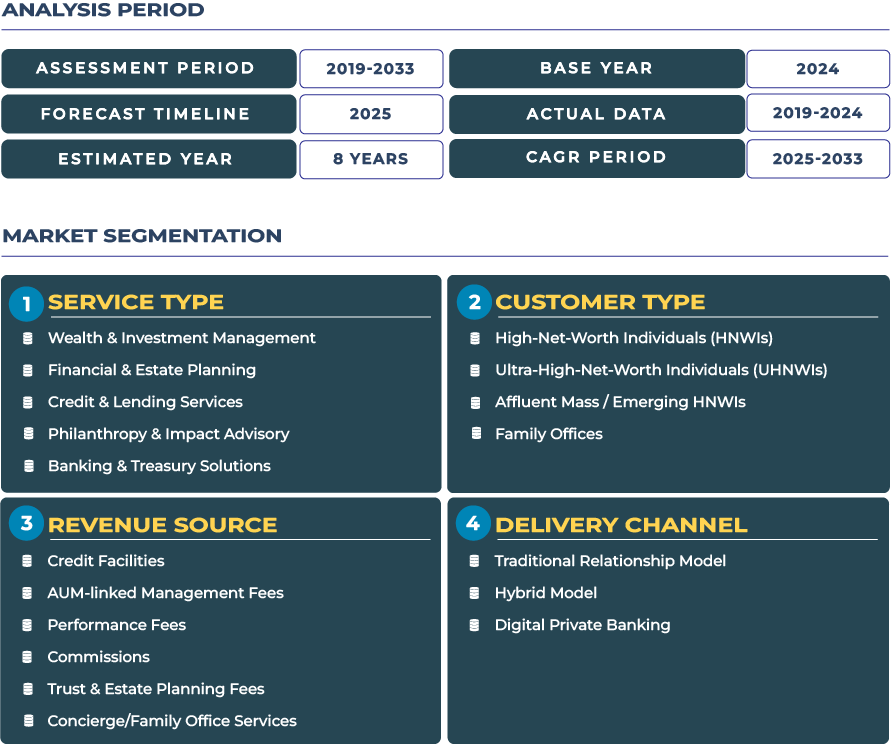Market Outlook: Unlocking the Growth Trajectory for the ASEAN Private Banking Landscape through 2033
ASEAN private banking market speaks to a blend of digital-wealth expansion and structural growth. From an estimated USD 80.0 billion in 2025 to reaching around USD 121.1 billion by 2033, the 5.3% CAGR highlights meaningful momentum. Growth is driven by rising entrepreneurial wealth, regional integration efforts like the Association of Southeast Asian Nations (ASEAN) capital-mobility frameworks, and the surge in digitally empowered affluent clients seeking private-banking services aligned with modern expectation.
Note:* The market size refers to the total revenue generated by banks through various services.
In practical terms, private banks in the region will need to pivot away from legacy models and adopt mobile-first advisory, wealth-platform orchestration, integrated banking/treasury flows and subscription-style service pricing to capture the growth curve. Additionally, ASEAN’s demographic tilt toward younger wealthy cohorts and increasing wealth transfers among families create a future-oriented service dynamic. For firms that build scalable digital platforms, regional wealth-mobility capability and multi-jurisdictional advisory, the projected market growth offers both volume and value-chain-elevation opportunity.
Growth Catalysts & Structural Constraints: What Fuels and What Limits the ASEAN Private Banking Market
The ASEAN private banking sector is powered by key structural factors: First, rising affluence across Southeast Asia-accelerated by SME growth, tech-enabled entrepreneurship and domestic wealth creation-creates increasing demand for wealth & investment management, estate planning and legacy services. Second, regional integration initiatives-such as the ASEAN Economic Community-enhance cross-border service potential, enabling private banks to cater to mobile wealthy clients across multiple jurisdictions. Third, digital-banking growth is enabling private banking to scale: mobile onboarding, robo-advisory supplements, embedded payments/treasury and wealth-platform ecosystems reduce cost-to-serve and unlock new client segments.
On the flip side, the ASEAN private banking market navigates several constraints. Regulatory divergence among ASEAN member countries-differences in KYC/AML, taxation and wealth-structuring rules-adds complexity and cost to cross-border service models. Talent shortage in wealth-advisory and digital-wealth roles limits some firms’ capacity to scale high-value services in a competitive market. Currency volatility and macro-economic uncertainty-especially in emerging ASEAN economies-also present risk for portfolios and client confidence. Consequently, while growth is promising, private banks must focus on service quality, digital scale and cross-jurisdictional consistency to realise the full potential of the market.
Trend-Vectors & Opportunity Windows: Digital-Only Private Banks, ESG Wealth Mandates & Cross-Border UHNW Services in the ASEAN Private Banking Market
Among the major trend-vectors in the ASEAN private banking market are: digital-only private-banking platforms tailored to affluent and next-gen wealth segments; ESG-wealth mandates where clients demand sustainable and impact-aligned investment portfolios; and regional wallet integration-wealth clients across the region expect seamless movement of assets, multi-currency treasury and real-time advisory via mobile channels.
Private banks in ASEAN can capitalise on several attractive opportunity frames by developing regional digital private banking platforms that are mobile-first and cater to affluent clients across multiple ASEAN jurisdictions, enabling scale and service consistency. They can also strengthen cross-border ultra-high-net-worth services by supporting families operating across Indonesia, Singapore, Vietnam, Thailand, and Malaysia with integrated wealth structuring, estate planning, and international investment access. Additionally, expanding ESG mandates for affluent investors through impact-wealth advisory, sustainable asset portfolios, and philanthropy tools aligned with regional values around sustainability and generational legacy will enhance competitiveness. Firms that act on these opportunities will be well positioned to capture a disproportionate share of ASEAN private banking market growth.
Competitive Landscape: Strategic Positioning and Platform-Orchestration in the ASEAN Private Banking Market
Competition in the ASEAN private banking market is increasingly about platform and service orchestration rather than purely product distribution. A prominent institution such as DBS Bank demonstrated regional leadership with its digital banking platform and private banking arm across Southeast Asia. Market players are activating strategies including segment-differentiation (such as next-gen affluent vs ultra-HNW), digital platform deployment (mobile onboarding, integrated treasury/wealth dashboards), and regional partnerships (with fintechs, wealth-tech providers and cross-border advisory networks). Those private banks that can integrate wealth & investment management, estate & legacy advisory, credit & lending overlays, philanthropy & impact frameworks and banking & treasury solutions into unified digital ecosystems will differentiate in the ASEAN private banking landscape.








